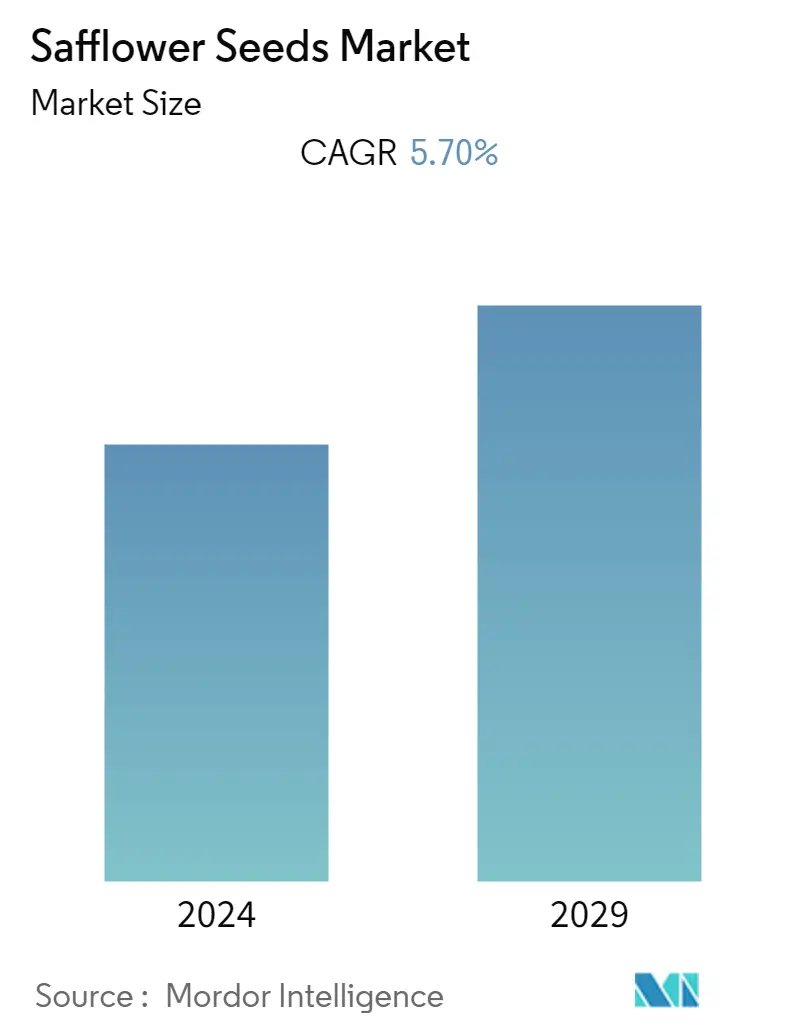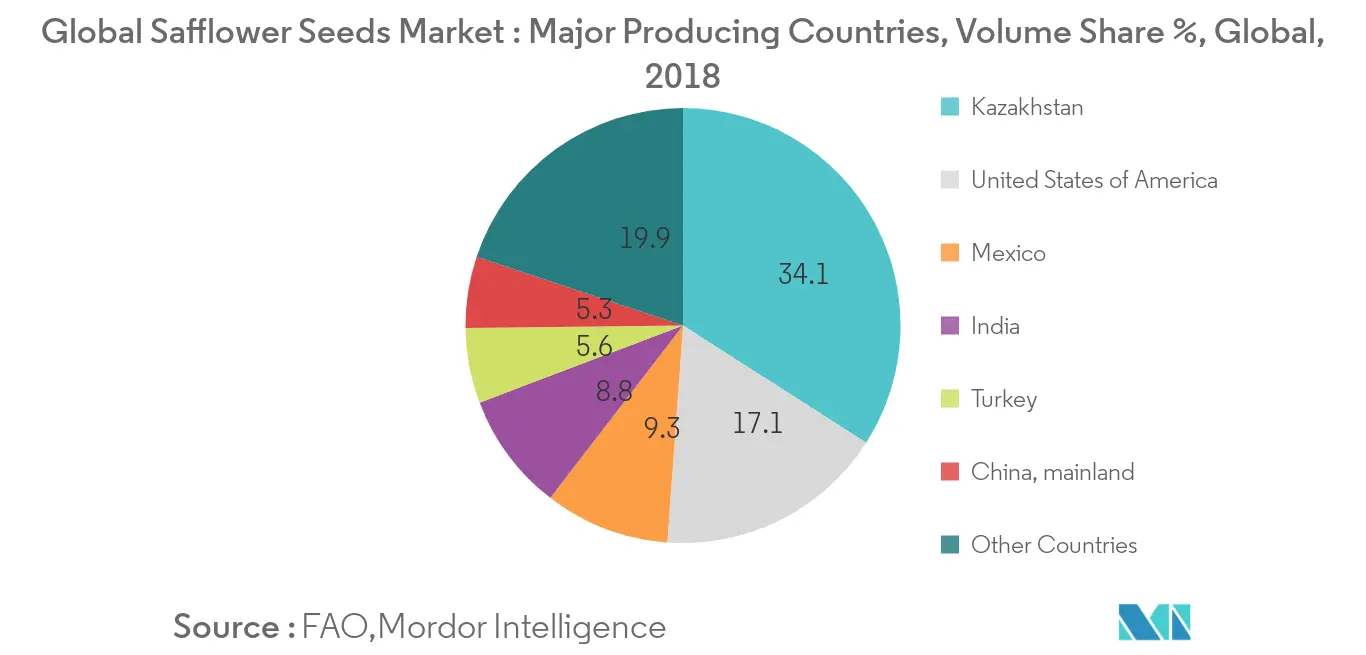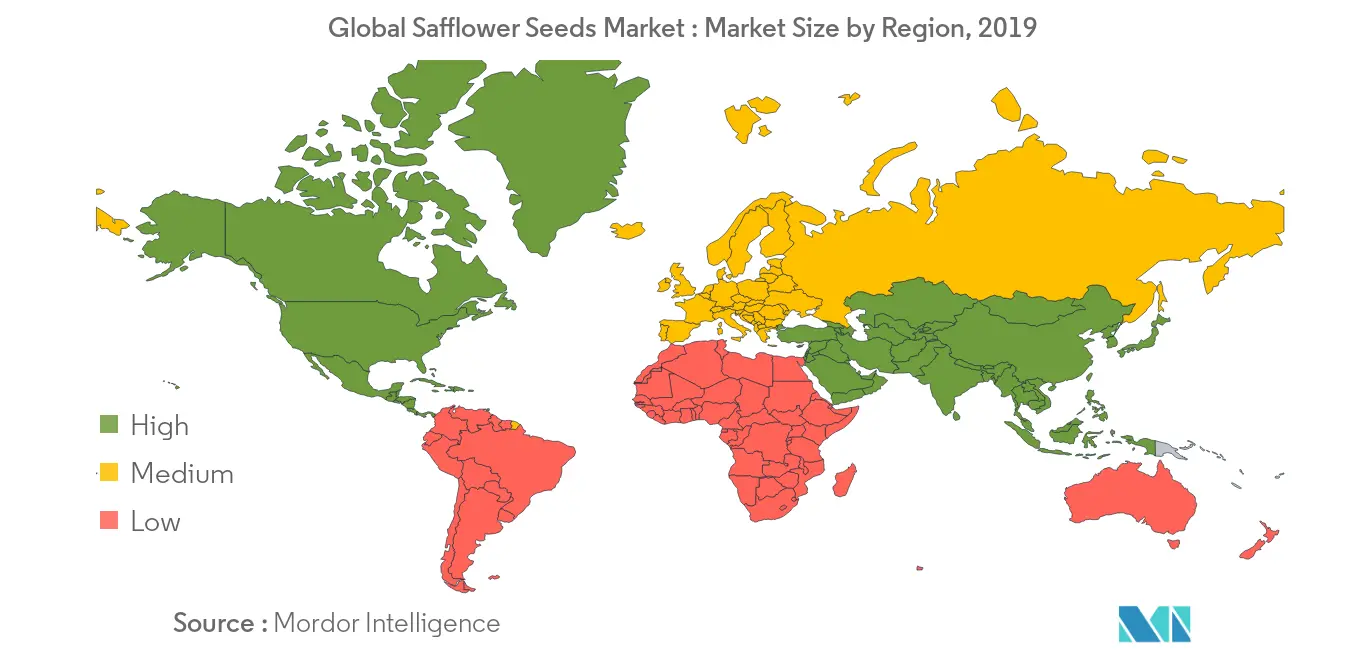Safflower Seeds Market Size

| Study Period | 2019 - 2029 |
| Base Year For Estimation | 2023 |
| Forecast Data Period | 2024 - 2029 |
| CAGR | 5.70 % |
| Fastest Growing Market | North America |
| Largest Market | Middle-East and Africa |
Major Players
*Disclaimer: Major Players sorted in no particular order |
Safflower Seeds Market Analysis
The safflower seeds market is projected to reach a CAGR of 5.7% over the forecast period (2020-2025). The global safflower oil consumption is growing rapidly, mainly as a result of the rising health consciousness among consumers across the world. Safflower oil is a popular cooking oil that comes from the seeds of the safflower plant. According to the Food and Agriculture Organization (FAO), Kazakhstan, India, the United States of America, Mexico, Argentina, and Australia are the primary producers of safflower seed mainly for oil extraction rotational crops along with rice, wheat, and corn. According to FAO, Kazakhstan produced safflower seeds of 214149 tonnes in 2018 up from 167243 tonnes in 2016. Safflower seed production in Kazakhstan exceeded the figures recorded by the second-largest producer, the U.S. (107220 tonnes, 2018), threefold. California is the primary producer of safflower seeds in the united states, accounting for 50% of the production. Safflower seed is a drought-tolerant oilseed, with Lower production inputs, easy adaptability to various soil types, effective in crop rotation, effective weed and disease controller, Lower risk of production, ease of harvesting and storage are some of the factors driving the demand for safflower seed across the globe.
Safflower Seeds Market Trends
This section covers the major market trends shaping the Safflower Seeds Market according to our research experts:
Increased Commercialization of Safflower oil and By Products
According to the Agricultural Marketing Resource Centre (AgMRC), the safflower oil, which is a monounsaturated and polyunsaturated state is used in infant formulas, cosmetics, and salad and cooking oils. Both types of oil are considered 'high-quality' edible oil, and public awareness about its health benefits have made safflower an essential crop for vegetable oil. The oil in linoleic safflower contains nearly 75 % linoleic acid and is used primarily for edible oil products such as salad oils and soft margarine. Safflower meal, by-product after the oil extraction is about 24% protein and is high in fiber and is used as a protein supplement for livestock and poultry feed. A recent innovation in the oil extraction process using supercritical CO2 tends to provide superior oil quality compared to the traditionally extracted oil. In the year 2020, under the Crop Biofactories Initiative, the company has developed the Super High Oleic safflower oil with the help of CSIRO's gene silencing technology that has resulted in SHO which has over 92% oleic acid. With the minimal safflower seed production in the country, the Australian companies have developed one of the superior quality oil of all the other plant kind which has shown a considerable demand for the safflower seed in the Australian Market.

Russia Leads Export of Safflower Seeds
Russia is a significant producer of safflower seeds alongside being the leading exporter of the same. According to ITC Trade Map, in 2019, the country exported safflower seeds worth USD 16.3 million with 52,539 tons. Some of the major exporting countries are Turkey, Belgium, Poland, Netherlands, and others. In 2019, safflower culture is grown on the territory of the Russian Federation mainly in the Southern Federal District, the Volga Federal District and the Republic of Kalmykia. In 2018, The national project "Export of Agricultural Products" the Russian Federation government consolidated the oil and fat industry (to which safflower also belongs) as one of the key factors for the growth of total trade turnover until 2024. As part of this project, there is planned to be an almost triple increase in oil and fat products exports until 2024. Safflower seeds are a popular crop in the region and are mainly used for safflower oil extraction, in addition to being used for bird food and also in cosmetics. Benefits of safflower oil such as reduction of cholesterol levels, management of blood sugar, aiding in weight loss, improving hair, and skin health contribute to its growing popularity, which in turn is aiding exports from the region.

Safflower Seeds Market Report - Table of Contents
1. INTRODUCTION
- 1.1 Study Deliverables
- 1.2 Study Assumptions
- 1.3 Scope of the Study
2. RESEARCH METHODOLOGY
3. EXECUTIVE SUMMARY
4. MARKET DYNAMICS
- 4.1 Market Overview
- 4.2 Market Drivers
- 4.3 Market Restraints
- 4.4 Value Chain Analysis
5. MARKET SEGMENTATION
-
5.1 Geography
- 5.1.1 North America
- 5.1.1.1 United States
- 5.1.1.1.1 Production Analysis
- 5.1.1.1.2 Consumption Analysis and Market Value
- 5.1.1.1.3 Import Market Analysis by Volume & Value
- 5.1.1.1.4 Export Market Analysis by Volume & Value
- 5.1.1.1.5 Price Trend Analysis
- 5.1.1.2 Mexico
- 5.1.1.2.1 Production Analysis
- 5.1.1.2.2 Consumption Analysis and Market Value
- 5.1.1.2.3 Import Market Analysis by Volume & Value
- 5.1.1.2.4 Export Market Analysis by Volume & Value
- 5.1.1.2.5 Price Trend Analysis
- 5.1.2 Europe
- 5.1.2.1 Russia
- 5.1.2.1.1 Production Analysis
- 5.1.2.1.2 Consumption Analysis and Market Value
- 5.1.2.1.3 Import Market Analysis by Volume & Value
- 5.1.2.1.4 Export Market Analysis by Volume & Value
- 5.1.2.1.5 Price Trend Analysis
- 5.1.2.2 Spain
- 5.1.2.2.1 Production Analysis
- 5.1.2.2.2 Consumption Analysis and Market Value
- 5.1.2.2.3 Import Market Analysis by Volume & Value
- 5.1.2.2.4 Export Market Analysis by Volume & Value
- 5.1.2.2.5 Price Trend Analysis
- 5.1.3 Asia Pacific
- 5.1.3.1 China
- 5.1.3.1.1 Production Analysis
- 5.1.3.1.2 Consumption Analysis and Market Value
- 5.1.3.1.3 Import Market Analysis by Volume & Value
- 5.1.3.1.4 Export Market Analysis by Volume & Value
- 5.1.3.1.5 Price Trend Analysis
- 5.1.3.2 India
- 5.1.3.2.1 Production Analysis
- 5.1.3.2.2 Consumption Analysis and Market Value
- 5.1.3.2.3 Import Market Analysis by Volume & Value
- 5.1.3.2.4 Export Market Analysis by Volume & Value
- 5.1.3.2.5 Price Trend Analysis
- 5.1.3.3 Australia
- 5.1.3.3.1 Production Analysis
- 5.1.3.3.2 Consumption Analysis and Market Value
- 5.1.3.3.3 Import Market Analysis by Volume & Value
- 5.1.3.3.4 Export Market Analysis by Volume & Value
- 5.1.3.3.5 Price Trend Analysis
- 5.1.4 South America
- 5.1.4.1 Argentina
- 5.1.4.1.1 Production Analysis
- 5.1.4.1.2 Consumption Analysis and Market Value
- 5.1.4.1.3 Import Market Analysis by Volume & Value
- 5.1.4.1.4 Export Market Analysis by Volume & Value
- 5.1.4.1.5 Price Trend Analysis
- 5.1.5 Middle East & Africa
- 5.1.5.1 Turkey
- 5.1.5.1.1 Production Analysis
- 5.1.5.1.2 Consumption Analysis and Market Value
- 5.1.5.1.3 Import Market Analysis by Volume & Value
- 5.1.5.1.4 Export Market Analysis by Volume & Value
- 5.1.5.1.5 Price Trend Analysis
- 5.1.5.2 Tanzania
- 5.1.5.2.1 Production Analysis
- 5.1.5.2.2 Consumption Analysis and Market Value
- 5.1.5.2.3 Import Market Analysis by Volume & Value
- 5.1.5.2.4 Export Market Analysis by Volume & Value
- 5.1.5.2.5 Price Trend Analysis
- 5.1.5.3 Kazakhstan
- 5.1.5.3.1 Production Analysis
- 5.1.5.3.2 Consumption Analysis and Market Value
- 5.1.5.3.3 Import Market Analysis by Volume & Value
- 5.1.5.3.4 Export Market Analysis by Volume & Value
- 5.1.5.3.5 Price Trend Analysis
- 5.1.5.4 Kyrgyzstan
- 5.1.5.4.1 Production Analysis
- 5.1.5.4.2 Consumption Analysis and Market Value
- 5.1.5.4.3 Import Market Analysis by Volume & Value
- 5.1.5.4.4 Export Market Analysis by Volume & Value
- 5.1.5.4.5 Price Trend Analysis
- 5.1.5.5 Iran
- 5.1.5.5.1 Production Analysis
- 5.1.5.5.2 Consumption Analysis and Market Value
- 5.1.5.5.3 Import Market Analysis by Volume & Value
- 5.1.5.5.4 Export Market Analysis by Volume & Value
- 5.1.5.5.5 Price Trend Analysis
- 5.1.5.6 Ethiopia
- 5.1.5.6.1 Production Analysis
- 5.1.5.6.2 Consumption Analysis and Market Value
- 5.1.5.6.3 Import Market Analysis by Volume & Value
- 5.1.5.6.4 Export Market Analysis by Volume & Value
- 5.1.5.6.5 Price Trend Analysis
6. MARKET OPPORTUNITIES AND FUTURE TRENDS
** Subject To AvailablitySafflower Seeds Industry Segmentation
Safflower seeds are fruits of the safflower plant, which are produced majorly in the Middle Eastern and North American countries. There are two main types of safflower, one type of safflower produces seeds that are high in monounsaturated fatty acid, while the other produces seeds that are high in polyunsaturated fatty acid. The report covers safflower seeds (Carthamus tinctorius) production, consumption, trade, and price trend analysis.
| Geography | North America | United States | Production Analysis |
| Consumption Analysis and Market Value | |||
| Import Market Analysis by Volume & Value | |||
| Export Market Analysis by Volume & Value | |||
| Price Trend Analysis | |||
| Geography | North America | Mexico | Production Analysis |
| Consumption Analysis and Market Value | |||
| Import Market Analysis by Volume & Value | |||
| Export Market Analysis by Volume & Value | |||
| Price Trend Analysis | |||
| Geography | Europe | Russia | Production Analysis |
| Consumption Analysis and Market Value | |||
| Import Market Analysis by Volume & Value | |||
| Export Market Analysis by Volume & Value | |||
| Price Trend Analysis | |||
| Geography | Europe | Spain | Production Analysis |
| Consumption Analysis and Market Value | |||
| Import Market Analysis by Volume & Value | |||
| Export Market Analysis by Volume & Value | |||
| Price Trend Analysis | |||
| Geography | Asia Pacific | China | Production Analysis |
| Consumption Analysis and Market Value | |||
| Import Market Analysis by Volume & Value | |||
| Export Market Analysis by Volume & Value | |||
| Price Trend Analysis | |||
| Geography | Asia Pacific | India | Production Analysis |
| Consumption Analysis and Market Value | |||
| Import Market Analysis by Volume & Value | |||
| Export Market Analysis by Volume & Value | |||
| Price Trend Analysis | |||
| Geography | Asia Pacific | Australia | Production Analysis |
| Consumption Analysis and Market Value | |||
| Import Market Analysis by Volume & Value | |||
| Export Market Analysis by Volume & Value | |||
| Price Trend Analysis | |||
| Geography | South America | Argentina | Production Analysis |
| Consumption Analysis and Market Value | |||
| Import Market Analysis by Volume & Value | |||
| Export Market Analysis by Volume & Value | |||
| Price Trend Analysis | |||
| Geography | Middle East & Africa | Turkey | Production Analysis |
| Consumption Analysis and Market Value | |||
| Import Market Analysis by Volume & Value | |||
| Export Market Analysis by Volume & Value | |||
| Price Trend Analysis | |||
| Geography | Middle East & Africa | Tanzania | Production Analysis |
| Consumption Analysis and Market Value | |||
| Import Market Analysis by Volume & Value | |||
| Export Market Analysis by Volume & Value | |||
| Price Trend Analysis | |||
| Geography | Middle East & Africa | Kazakhstan | Production Analysis |
| Consumption Analysis and Market Value | |||
| Import Market Analysis by Volume & Value | |||
| Export Market Analysis by Volume & Value | |||
| Price Trend Analysis | |||
| Geography | Middle East & Africa | Kyrgyzstan | Production Analysis |
| Consumption Analysis and Market Value | |||
| Import Market Analysis by Volume & Value | |||
| Export Market Analysis by Volume & Value | |||
| Price Trend Analysis | |||
| Geography | Middle East & Africa | Iran | Production Analysis |
| Consumption Analysis and Market Value | |||
| Import Market Analysis by Volume & Value | |||
| Export Market Analysis by Volume & Value | |||
| Price Trend Analysis | |||
| Geography | Middle East & Africa | Ethiopia | Production Analysis |
| Consumption Analysis and Market Value | |||
| Import Market Analysis by Volume & Value | |||
| Export Market Analysis by Volume & Value | |||
| Price Trend Analysis |
Safflower Seeds Market Research FAQs
What is the current Safflower Seeds Market size?
The Safflower Seeds Market is projected to register a CAGR of 5.70% during the forecast period (2024-2029)
Which is the fastest growing region in Safflower Seeds Market?
North America is estimated to grow at the highest CAGR over the forecast period (2024-2029).
Which region has the biggest share in Safflower Seeds Market?
In 2024, the Middle-East and Africa accounts for the largest market share in Safflower Seeds Market.
What years does this Safflower Seeds Market cover?
The report covers the Safflower Seeds Market historical market size for years: 2019, 2020, 2021, 2022 and 2023. The report also forecasts the Safflower Seeds Market size for years: 2024, 2025, 2026, 2027, 2028 and 2029.
Safflower Seeds Industry Report
Statistics for the 2024 Safflower Seeds market share, size and revenue growth rate, created by Mordor Intelligence™ Industry Reports. Safflower Seeds analysis includes a market forecast outlook to 2029 and historical overview. Get a sample of this industry analysis as a free report PDF download.



